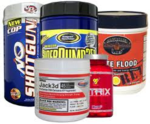|
Nitric Oxide’s Claim to Fame
“Pre-workout” Supplement which increases Nitric Oxide (NO) production, delivery of a muscle pump and an overall increase in training intensity and performance by increasing oxygen and nutrient delivery as well as decreasing the rate of fatigue.
What is it?
NO products are predominately a cocktail of L-arginine and L-Citrulline Malate amino acids which are oxised to NO by an enzyme known as NO synthase and Ginseng to provide stimulating effects providing the sensation of increased energy levels. Therefore No supplements are through to be an ergogenic aid. Based on the fact that NO is an important modulator of blood flow and cellular respiration during exercise
Value for money??
The amounts of L-arginine and L-Citrulline Malate per serve in a commercial NO-stimulating product are extremely low and ineffective to induce changes in NO. The average cost is $114.95 for 60 serves, equating to $1.92 per serve. Research shows males require 6g L-arginine and females 14.2g for any signs of performance benefits. Costing Males: $3.84 per serve and Females: $9.09 per serve.

The Evidence
Now lets look at research which are reputal, they are currently few and further between on NO. There is some evidence NO is a vasodilator, which improves cardiac parameters and performance in hypoxic environments (ie altitude) (Lavalle & Mason, 2012) . 6g of L-Arginine one hour before training in males has shown an in performance in VO2 Max and increase time to fatigue (Bescos, Sureda, Tur, & Pons, 2012).
Females receiving a dose of 14.2g/day for 6 months showed an increase in max power output. A comprehensive study by Bloomer et al. (2010) of commercial NO supplements resulted in no difference in exercise performance, skeletal muscle bloodflow, muscle pump, blood lactate or blood nitrite levels to those in a control group taking Maltodextrin (form of carbohydrate) (Bloomer, et al., 2010) .
Conclusion
Still tempted by the claims of increased blood flow, improved performance and enhanced recovery? Although NO is indeed a important signalling molecule, there is currently no direct evidence that commercial grade NO supplements promotes effect on exercise performance or recovery (Bloomer, Williams, Canale, Farney, & Kabir, 2010)
Works cited
Bescos, R., Sureda, A., Tur, J., & Pons, A. (2012). The Effect of Nitric-Oxide-Related
Supplements on Human Performance. Journal of Sports Medicine , 42(2), 99-117.
Bloomer, R. J., Farney, T. M., Trepanowski, J., McCarthy, C. G., Canale, R., & Schilling, B. (2010). Research article: Comparison of pre-workout Nitric Oxide stimulating dietary supplements on skeletal muscle oxygen saturation, blood nitrate/nitrite, lipid peroxidation, and upper body exercise performance in resistance trained men. Journal of the International Society of Sports Nutrition , 7(16), 4-15.
Bloomer, R., Williams, S. A., Canale, R., Farney, T. M., & Kabir, M. (2010). Acute Effect of Nitric Oxide Supplement on Blood Nitrate/ Nitrite and Hemodynamic Variables in Resistance Trained Men. Journal of Strength and Conditioning Research, 24(10), 2587-2592.
Lavalle, M., & Mason, B. (2012). Sports Health: A Multidisciplinary Approach. American Orthopaedic Society for Sports Medicine, 4, 142-146.
Amanda Foubister, February 2013
BSc (HumNutr, ExSptSc)
ASCA | Level 2
S & C Coach
ISAK | Accredited
|



